
The “boomer-shooter” inspirations are clear in New Blood’s Dusk, but it does far more than imitate what came before.
Many developers grew up with the likes of Quake, Doom, Duke Nukem 3D, or Blood; and whenever there is a retro throw-back boomer shooter, usually the developer only captures the superficial aspects of shooters of yesteryear. It’s easy to be a copy-cat, but to take the foundation of 90s first-person shooters and build off and improve it, takes talent.
David Szymanski knows his shooters very well. He lends a unique voice to the sea of boomer-shooters with Dusk, and manages to add new ideas with his sense of style. There are the obvious influences like the aforementioned Blood, with the rural and cult-like ambiance and the Eldritch cosmic elements and early chunky 3D graphics like Quake.
Szymanski’s experiences as a player informs a lot of the nuances in Dusk. It’s apparent he understands the best and worst aspects of first-person action, and much of what makes Dusk so enjoyable is how the designer addresses these features; artistically and mechanically.
Dusk
Developer: New Blood Interactive
Publisher: New Blood
Platforms: Windows PC, Linux, Mac, Nintendo Switch (reviewed)
Release Date: December 10, 2018 (Windows PC, Linux, Mac), October 28, 2021 (Nintendo Switch)
Players: 1
Price: $19.99 USD
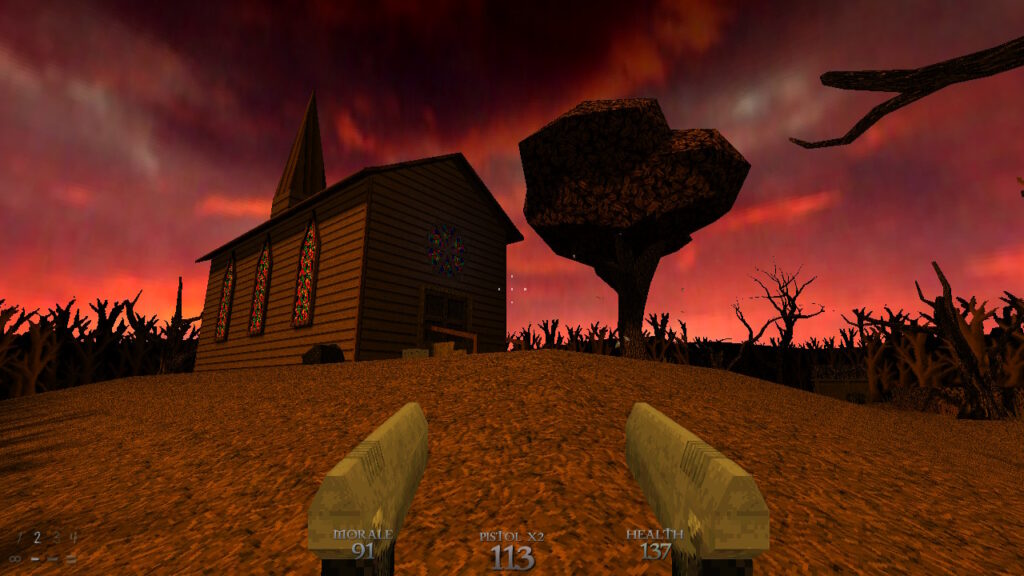
Like a good shooter, Dusk wastes no time throwing the player into the thick of it. The mysterious, unnamed player-character unhoists himself off a meat hook and three crazed chainsaw maniacs rush him. Armed with only two rusty sickles, the Duskman is immediately pitted against unbelievable odds. From that moment on, Dusk compounds on itself with the horror and unrelenting brutal action.
Duskman moves like a phantom, sweeping over the dry dead fields, spraying bullets and slashing at anything that moves. He can dual wield pistols and shotguns; bunny-hopping like a rabid gazelle that turns cultist rednecks into chunky pixelated gore. The range of action and interaction with the environment is far above what is expected from a game that looks so humble.
Sliding under projectiles or obstacles while unleashing a hellish scream from a machine gun is something that was never imaginable in shooters from the 90s. Cheeky enemies that snipe or flank around the player is the kind of behavior that is modern enough to make Dusk feel more innovative than other throw-back shooters.
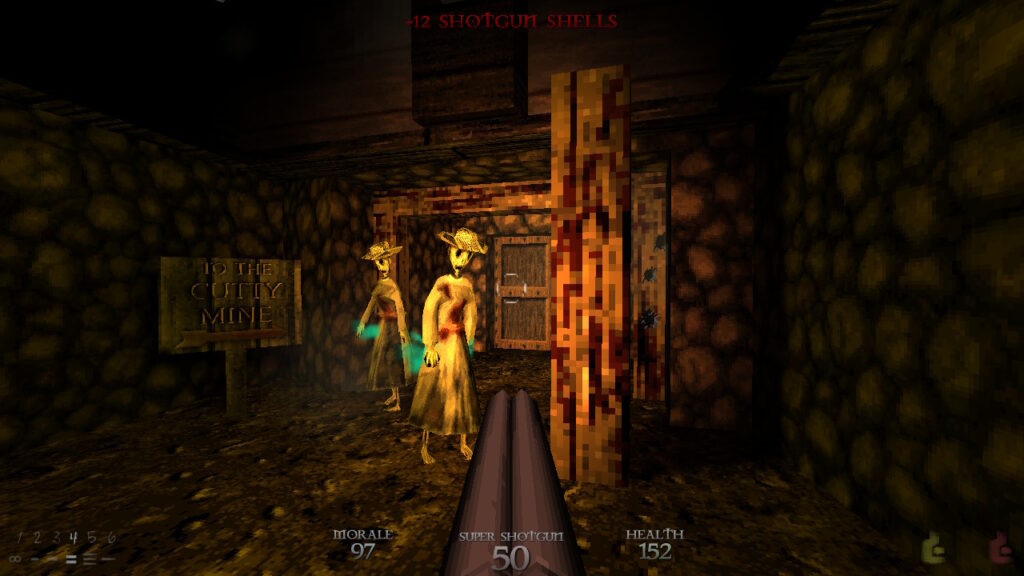
Duskman’s arsenal has many of the usual suspects; various kinds of shotguns, grenade launcher, and machine gun. The weapons that make Duskman stand out are the sword that can reflect projectiles, bowgun, rivet gun, and a long range sniper rifle with zoom function.
Some guns also tweak Duskman’s jump when fired downwards, which can be handy for clearing gaps or extending air time while blowing away wendigos and black goats. The range of movement and responsiveness of jumping allows for ridiculous mobility that is on par with the likes of Doom: Eternal.
Mowing down monsters and hillbillies is only half the fun. Where Dusk shines equally bright is in the level design and rewarding exploration, as well as discovering obscure secrets and lore. Though it may look it, this was not made with the Quake engine. Dusk is a Unity game, and comes with all the modern-day advancements for the designer to overcome the level design restrictions of real retro shooters.
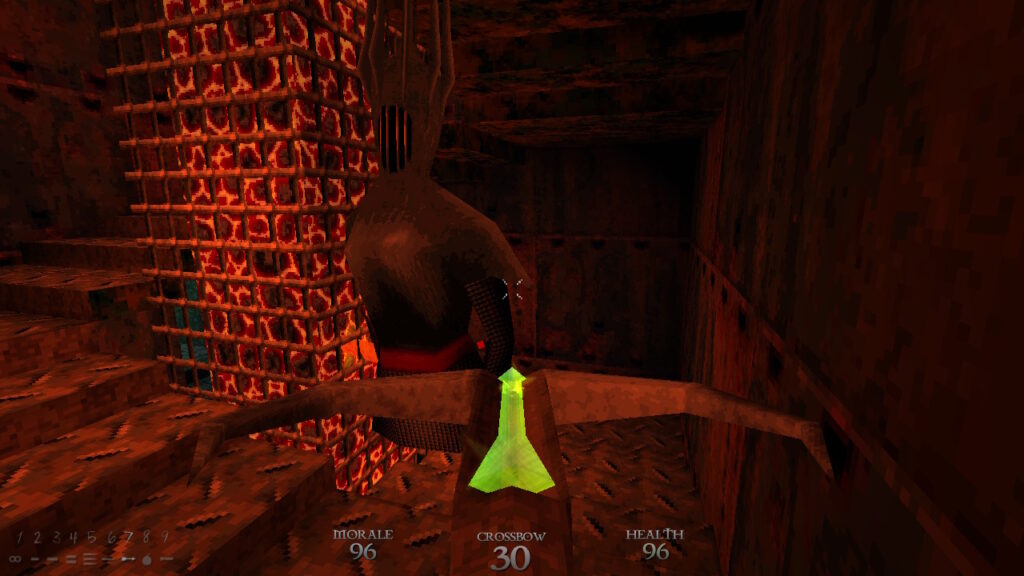
From dank dungeons, to scorched farmlands, diabolical laboratories to an underground city and beyond; Dusk has plenty of places for Duskman to raid. Each location is packed with secrets, and in some cases alternate routes that lead to hidden levels. Areas are large enough to feel immersive, but never confusing enough that players will wish there was a map.
Thanks to the retro-style visuals, making a mental map becomes natural. Specific landmarks stand out, and the variance of wide open spaces against the tight quarters of interiors keeps players on their toes to what may be around the corner. High structures that hide secrets will call out to gamers to explore a means to scale the environment, and to get immersed.
Enemies and their designs also benefit from the retro-inspired graphics. With a self-imposed polygon budget, the 3D modeler is forced to consider distinctive silhouettes for each enemy. The cast of baddies all stand out and are easy to read. Their animations also convey the type of attacks they will use. Subconsciously, players will register this and react accordingly.
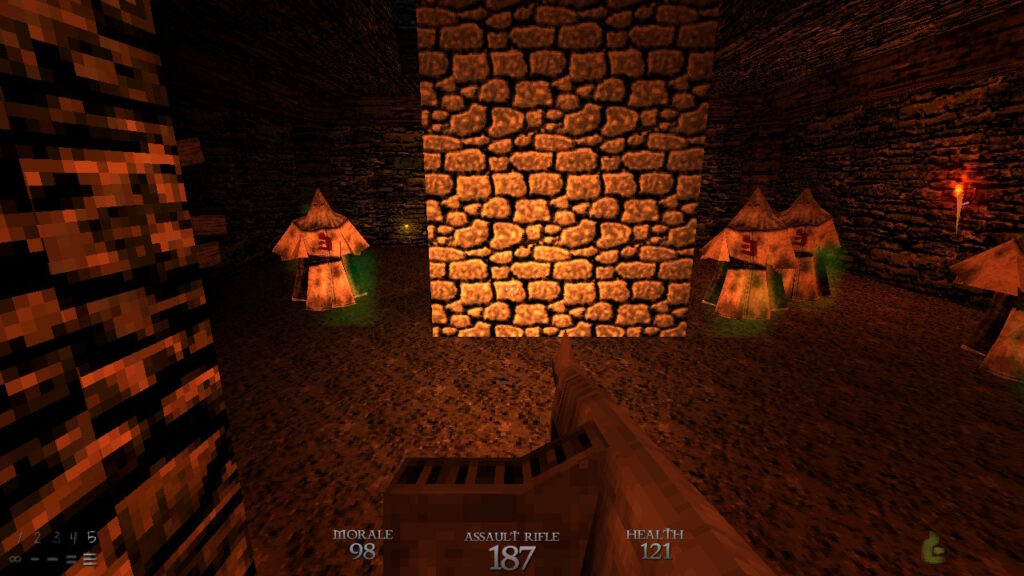
Many of Duskman’s weapons are hit-scan projectiles, but not the enemies. This evens the odds when facing a huge army of shot gun toting scarecrows who’s buckshot is visible and can be sidestepped. During the heat of a massive bloodbath, Dusk can take on the qualities of a bullet-hell shooter, as players will weave in and out of the line of fire.
Despite being made in Unity, Dusk on Nintendo Switch manages to run perfectly at 60 frames per second, and every frame counts in an action game this fast. No matter how much viscera, bullets, and flashy lighting effects are on screen, on TV mode or on the go; stability is unwavering and solid.
Porting to a console like Nintendo Switch could have been done quick and dirty, but the developers took the effort to improve the experience and take advantage of the controller’s features. A newly added weapon wheel makes it fluid and effortless to quickly juggle many different guns on the fly.
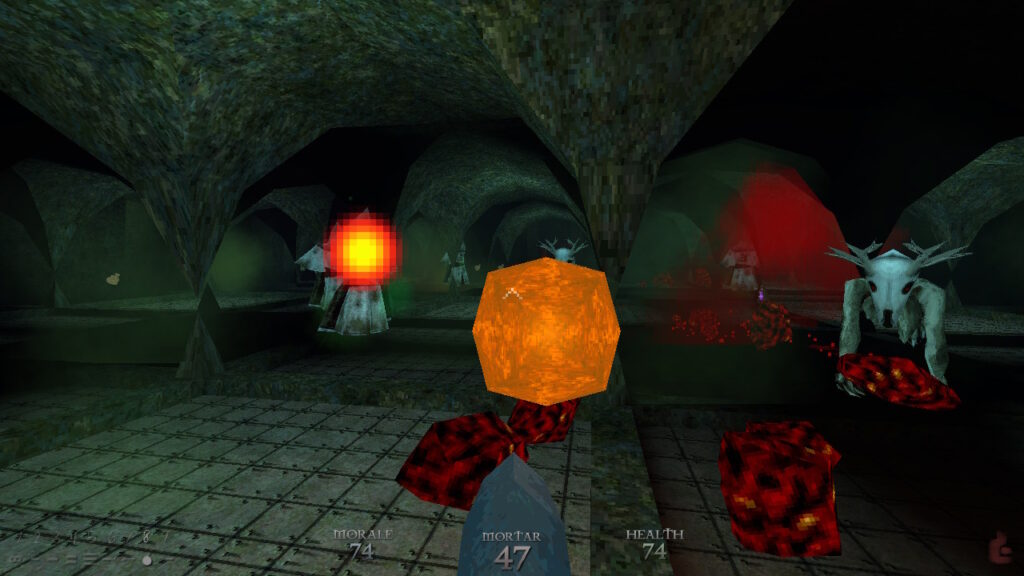
Dusk looks and plays like the best 90s era first-person shooter. Its art direction does all the leg work for the retro inspired graphics, and enhances the horror ambiance. Horror is pure psychology, and the best way to use psychology on the player is through abstraction.
When visuals are vague and raw, the human imagination runs wild and conjures up ideas far scarier that any artist can design. The power of suggestion always conquers all with horror, and Dusk uses every trick in the book. There is a strong use of mise-en-scène to explain the events that are happening in the story, since Dusk ascribes to the minimalist approach to its narrative.
On top of clever uses of environmental story-telling, Duskman is one of the few FPS protagonist who has some personality. He doesn’t have Duke Nukem-style one-liners, but he does get flavor text when players investigate various parts of the scenery. This is a very simple, yet effective means to convey a lot of information and in Dusk‘s case. It can change the way players will feel about everything in the campaign.
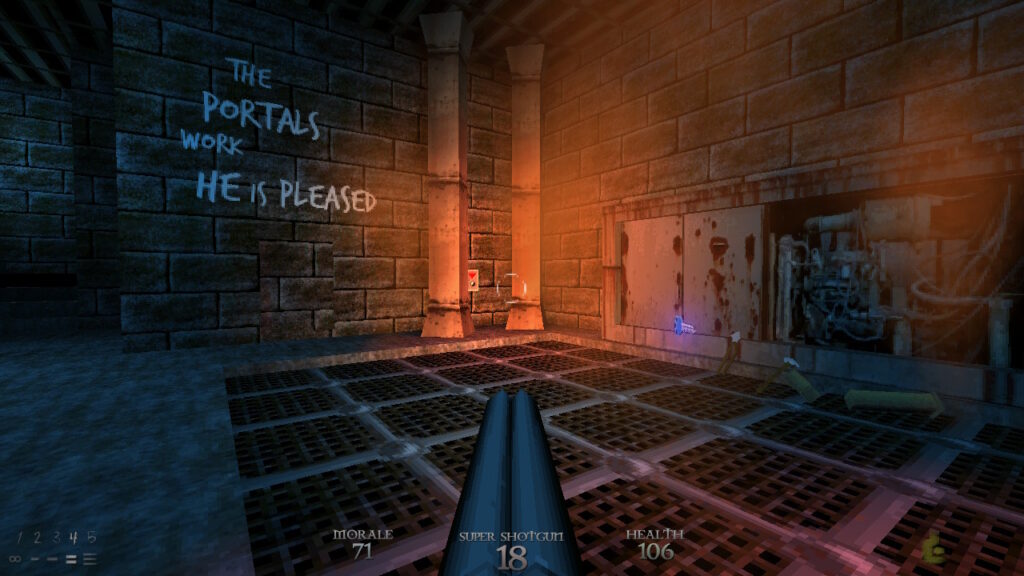
Dusk‘s narrative is not exactly deep, but it does have more going on in it than any of the games that inspired it. Throughout the scenario, paying close attention to details will paint a picture in the mind’s eye of the player. The deeper the player looks, the more accurate the picture becomes, and it all climaxes in a bittersweet finale.
Replaying stages will also reveal that seeds were being planted much earlier than initially thought. Sometimes late game enemies appear as corpses as early as the first stage. Some moments get recontextualized as their significance alters based on one interaction.
This underscored approach to the story draws the gamer deep into its world. The story feels more personal, since players have to do the work to piece the puzzle together themselves. Gamers get more involved in the setting, and the setting becomes more immersive.
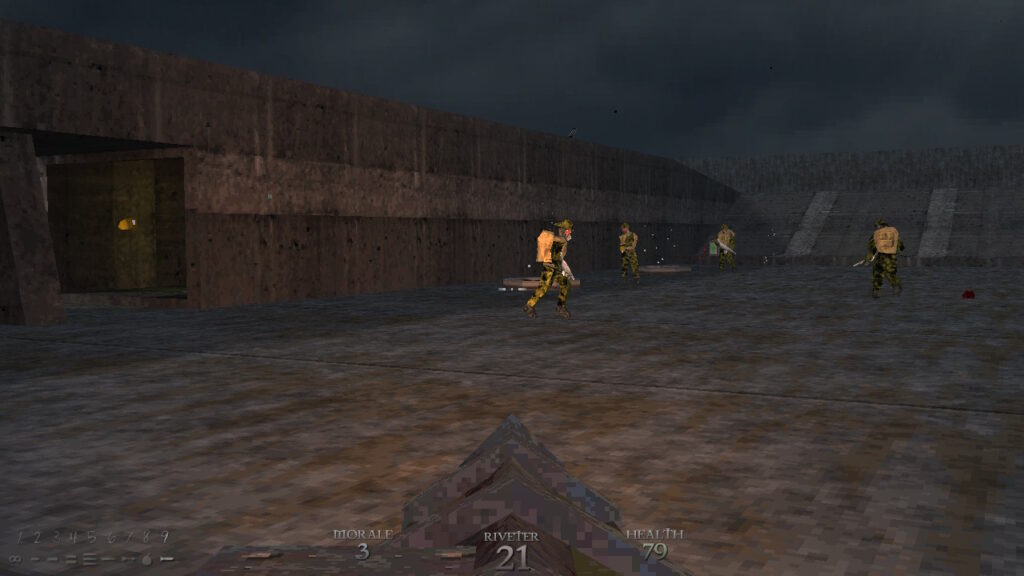
Another flourish in Dusk‘s design is how free-form it is with its scenarios. There is a lot of choice that most gamers might not be aware of; like how most bosses have a secret way to bypass them, or how objects that can be picked up can kill. Amusingly, the final boss can be defeated with a bar of soap.
There is never a moment when the player is cheated into a situation where they have to fight their way out. Dusk allows enough flexibility with its mechanics that it’s possible to speed run entire stages without killing anything. With so many points of interactivity within the game, it comes close to having elements of an immersive sim.
The endless horde mode is an amusing diversion, and plays to the strengths of Dusk‘s combat, pushing the player to see how long they can survive. Another Switch bonus is an extra stage modeled after Peach’s castle from Super Mario 64. Dusk is a game that keeps on giving, and being able to rip apart devil-worshipers in this nostalgic location taps into the inner-child; arming him with lots of guns.
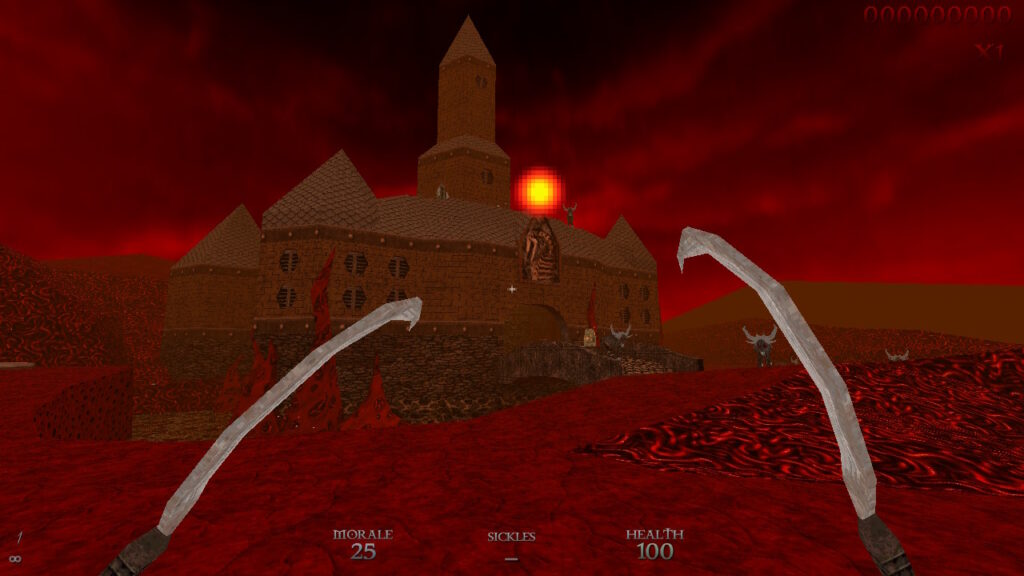
The music is another high point for Dusk. It’s an angry and aggressive style that makes the player feel like a bad guy. The game also knows when to pump up the music, and when to let players bask in silence so they can reflect upon the carnage of a gruesome aftermath.
There are several pieces of music that are especially memorable that have a smoldering anger vibe to them. It sounds like something from a violent early 80s exploitation movie. The music is rage incarnate, and will get blood to boil and inspire violent creativity.
Limited use of voice acting is mainly relied on making enemies distinct. Certain foes have lines of dialogue that are heard to signify their proximity to the player. Everyone sounds like a haggard and possessed maniac, which is fitting considering the premise of Dusk.
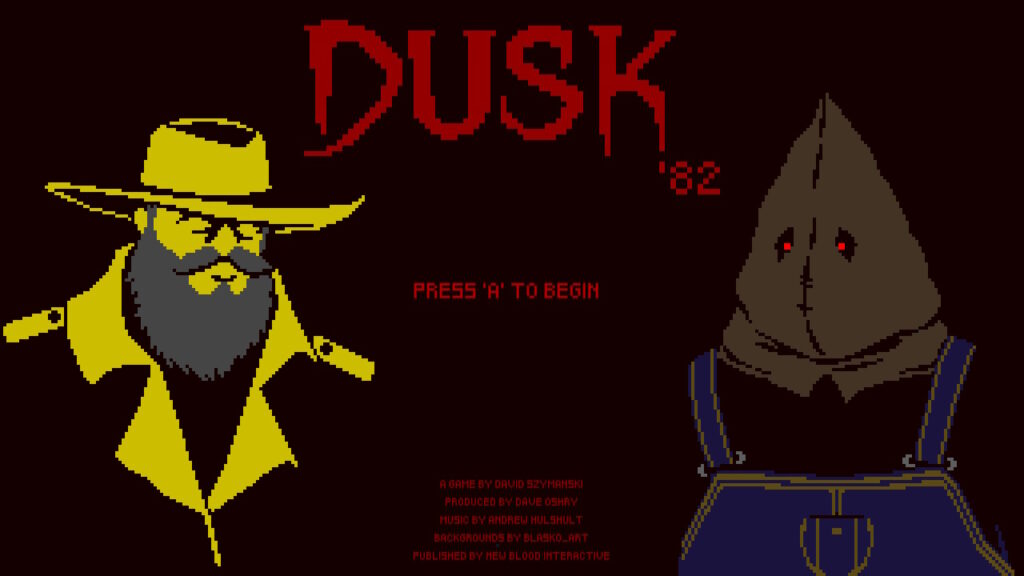
Anyone who pre-ordered Dusk on Nintendo Switch will also get a bonus game called Dusk ’84; a Berzerk-like step-based maze shooter. This is very much inspired by the kind of titles on Atari 2600 throughout the 80s. Characters would barely resemble what they represent, and gamers had to use their imagination a lot.
Despite the extremely limited visuals and simplistic gameplay, Dusk ’82 manages to be stimulating. Bordering on almost puzzle-game like rules, players have to figure out how to eliminate all threats on a map and then go to the exit. Roaming around is a liability, since there is a limited amount of steps players can make before they run out of energy, and enemies can only be killed by specific means.
Duskman in 82 can only carry one item at a time, which include weapons and keys. This means having to strategize an optimal route and what to pick up and when. Levels can become very tricky later on, and like the big boy Dusk, making it out alive can become a tense ride.
Dusk ’82 has a soundtrack that also remixes some of the familiar tunes from the main game. Most of the sound effects have the crunchy and white noise flair to them, as well as classic blips and bloops; a hallmark of video game sound effects from the early 80s.
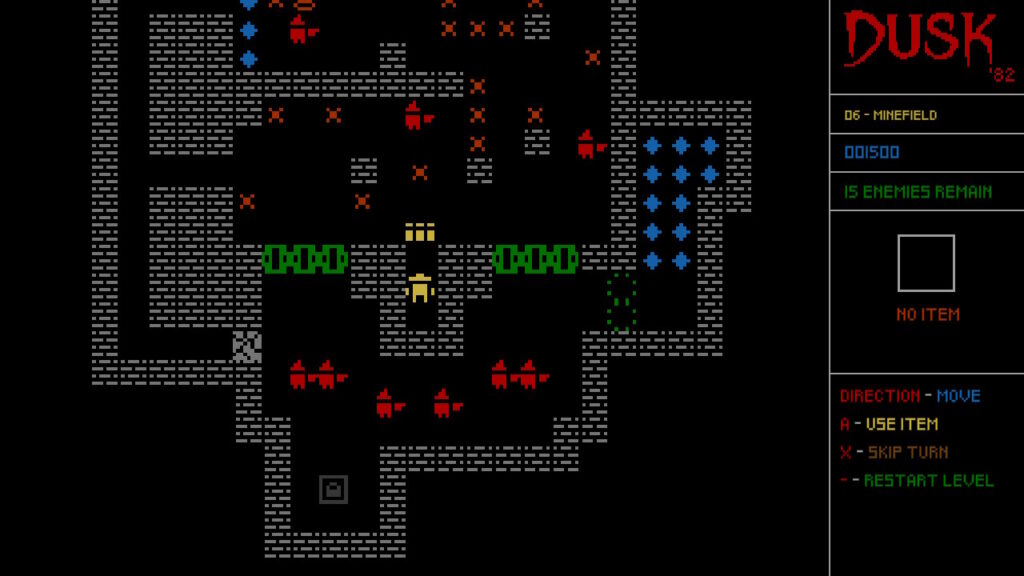
Dusk is one of the best first-person shooters ever made. That may sound like a bold statement considering that it’s such a modest game made to evoke the spirit of low-poly action from the 90s, but that’s because it’s so confidently designed. Dusk is more than the sum of its parts, and has more to say than just being “retro-inspired,” it simply is inspired.
With a story that is cheekily woven into the gameplay, rock solid action, air-tight controls to compliment an amazing gallery of enemies, level design, and weapons; Dusk has it all. The only problem with Dusk is the craven sensation felt when the game ends. There are few horror themed shooters that have the unbelievable rush that Dusk offers.
Dusk was reviewed on Nintendo Switch using a copy provided by New Blood. You can find additional information about Niche Gamer’s review/ethics policy here.